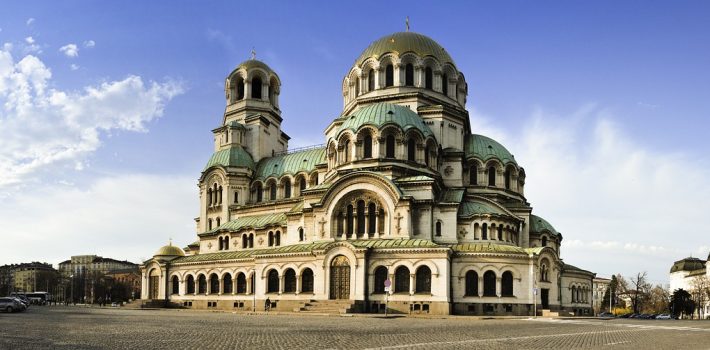City of Sofia – Bulgaria
Sofia – Bulgaria
is the capital and at the same time the largest city of the Republic of Bulgaria. The first impression that this city gives to someone coming from Serbia is that it has great similarities with Belgrade. They are similar in size, approximate number of inhabitants, in one street you see splendor in the other misery. You come out of the city center – grit and dirt. One of the strongest impressions is the approach to the airport from the north-eastern side – which passes through the gypsy small town.
A very large number of people travel from Belgrade to Sofia
City position
The city is located in the Sofia field, a huge, relatively flat basin considering the altitude, located between the mountains, Vitosha, Lyuljin and Stara Planina. It is located at an altitude of almost 600m, which makes it one of the highest capitals in Europe. It is interesting that, besides Madrid, it is one of the few European capitals that does not have at least a slightly larger river flowing through it.
History
Historical data show that the first settlement in that area was established by the Serdi tribe, after whom Sofia got its first name – Serdika. It was part of the Roman Empire, and from the 9th century the center of the Bulgarian Empire, Byzantium, until, like most of the Balkan peninsula, it fell under the rule of the Ottoman Empire until the end of the 19th century.
Name
It got its current name from the church of Saint Sophia, which was built in the 9th century on the remains of the Roman amphitheater from the 4th century. The name Serdika was lost over time, so it can be safely said that the current name dates back to the 14th century.
Tourist attractions
There is really a lot of history written in this city.
The main attraction of the city and the most visited object is the church of Alexander Nevsky, which was built by the Bulgarians as a sign of gratitude on the occasion of the Russo-Turkish war in the second half of the 19th century, after which Bulgaria was freed from centuries of slavery under the Turks.
The Church of the Holy Week or as some call it the Church of the Holy King is another Orthodox church in Sofia. It is the seat of the Sofia bishopric. It is assumed that it was built in the 20th century, most probably like all churches in Bulgaria at that time, made of wood. After a big fire in the 19th century, the whole thing burned down, after which it was rebuilt and took on its present appearance. Among the Orthodox believers, it is known as the I Church of the Holy King because it houses the relics of Serbian King Milutin, who were brought from Serbia under the Ottoman invasion in 1460.
Known in the city as the Russian Church is the Church of St. Nicholas the Wonderworker built on the site of a mosque and once built for the Russians who lived and still live in this city.
What else to see in Sofia?
One of the most beautiful boulevards, if not the most beautiful in this colorful city, is Vitoša Boulevard, which got its name from the mountain that, with its more than 2,000 meters, stands robustly above the city – Vitoša mountain. A wide pedestrian zone with plenty of restaurants and other shopping facilities, which, when you walk all the time, going towards the NDK, you can observe the white peaks of this mountain massif until the very beginning of summer.
There is a large number of wonderful buildings created in the 20th century. The parliament building – the so-called Narodno Sobranie, the headquarters and the palace of the president of the state, the buildings of all possible ministries – justice, finance, etc. look beautiful and decorated.
University
The building of the University of Sofia has a striking appearance in a beautiful location near Sofia’s largest parks, near the Eagle Bridge. Don’t be confused, although there are no rivers in Sofia, the Bulgarians had a need to build bridges – probably to give their capital a cosmopolitan look.
The University of Sofia, which bears the name Saint Clement of Ohrid, was founded in 1888. And there are 18 faculties in it.
Sports
As for the stadiums in Sofia, there are several more significant and larger ones: Vasil Levski, which is also the national stadium, CSKA Stadium, Lokomotiv, Slavia, as well as Levski Stadium.
One of Bulgaria’s national sports is volleyball, so from time to time significant tournaments such as the European Championship are held in Sofia.
Shopping in Sofia
Like any capital city, Sofia is full of nightlife, parties, restaurants, shopping malls and so on.
The most visited and at the same time the largest piers are:
The Mall
Mall of Sofia
Sofia Ring Mall
Serdika Mall
Bulgaria Mall
You will find all possible and impossible global and local brands in these monstrosities. The best times to shop are definitely January and August when you can really find great discounts. It is best for you to be petite or large, because medium-sized clothes and shoes are either the first to sell or not at all and do not receive discounts – as they say in the Bulgarian language – discount or reduction J
Where to get out
A handful of clubs, bars, taverns, restaurants, cafes. More famous names are:
Restaurants:
Skapto – Iskar
Taj Mahal Restaurant
Shtaslivetsa Vitoshka
Olio D’Oliva
Nikolas
Clubs:
Carousel
Sugar Club
Yalta
Club Mixtape5
Bedroom Premier Club
Culture Beat Club
Rock’n Roll
PM Club
Exe club
Traffic in Sofia
Although at first it seems chaotic, the traffic in Sofia is very well organized. It happens that public transport is relieved by the existence of the city’s Metro, which runs two lines. Traffic culture, I must admit, is at an enviable level. There are always free ones parking spaces for the disabled, you will always be allowed to turn in from a side street, to change lanes.
The airport in Sofia consists of two terminals, the older one, built before the Second World War, and the other, newer and bigger, Terminal 2, which was completed in 2009 with the help of the European Union. The airport can be reached from two directions, via Brussels Boulevard, which connects Tsarigradsko Shose with the airport, and via the northern tangent, through the picturesque Gypsy hood.













